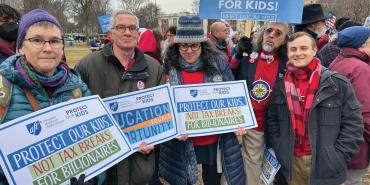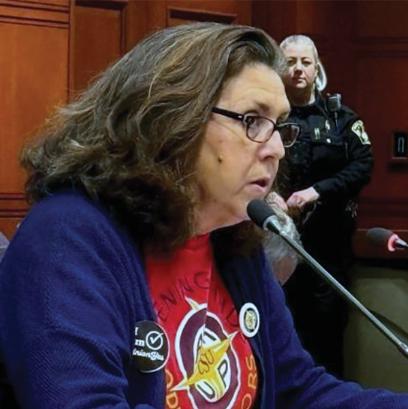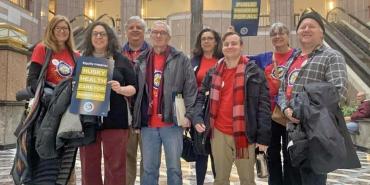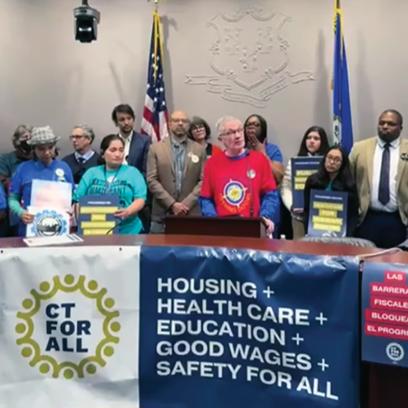President Franklin D. Roosevelt, who helped pull the nation out of the Great Depression and built the foundation for the American social safety net, said, “Democracy cannot succeed unless those who express their choice are prepared to choose wisely. The real safeguard of democracy, therefore, is education.”1 As extremists threaten to undermine democracy by attacking higher education, the AFT’s Real Solutions for Higher Education campaign seeks to counter the assault by making colleges and universities more accessible and affordable.
Expanding access to Connecticut’s public universities is the goal of legislation drafted and pushed by the Connecticut State University American Association of University Professors (CSU-AAUP), an AFT affiliate that represents about 3,000 faculty, librarians, counselors, coaches, and athletic trainers at the four state universities. This past June, CSU-AAUP succeeded in getting the Connecticut General Assembly to pass their bill extending free tuition from the community college to the state universities. To find out more about this exciting campaign to enhance opportunity for students, we spoke with CSU-AAUP President Louise Williams, who is a history professor at Central Connecticut State University, and CSU-AAUP Secretary John O’Connor, who is a sociology professor at Central Connecticut State University.
–EDITORS
EDITORS: Connecticut currently has a pathway for debt-free community college. How does that work?
LOUISE WILLIAMS: Connecticut’s four state universities and one community college with 12 campuses are part of a single system, the Connecticut State Colleges and Universities, with one board of regents. In 2019, the state legislature passed a bill that created the Pledge to Advance Connecticut (PACT)/the Mary Ann Handley Award to cover community college tuition and enable students to complete associate’s degrees debt-free. It is a “last-dollar” program that covers the remaining costs of tuition and fees after financial aid is used. Importantly, students are not expected to take out loans as part of their financial aid. There’s also a basic needs grant of up to $1,000 that covers anything from books to childcare for students whose tuition and fees are covered by a Pell Grant.2
The program has been successful in the community college. Last year, it served more than 13,000 students. Students receiving these funds are 17 percent more likely to persist from fall to spring and 9 percent more likely to graduate than their peers who are not receiving the funds.3
JOHN O’CONNOR: This higher education program is important because Connecticut is one of the wealthiest states in the nation, yet it is defined by serious levels of inequality.4 The progressive movement in Connecticut often points out that there are “two Connecticuts,” where opportunities and outcomes in the state are defined by our zip codes. One’s prospects in East Hartford are very different than those in West Hartford; same in Bridgeport and Westport.
EDITORS: How did you plan to make four-year degrees more accessible?
LOUISE: Extending the PACT/Handley Award—now renamed the Finish Line Scholars program—into the state universities was a broad, collective struggle. Our CSU-AAUP colleagues drafted a bill to extend the debt-free program to the four state universities. A version of that bill was folded into the state budget, creating a program in which students who received the PACT/Handley Award for community college will now be eligible for two more years of support at the state universities. We’d like to eventually expand this program to other students, so they can complete all four years at a state university without incurring huge debt.
Union members, students, community allies, union siblings, and legislators all worked in unison to get the win. We found sponsors in the legislature to introduce the bill, lobbied politicians, held a public hearing in the higher education committee, and got about 100 people to testify. Faculty and students continued their advocacy right up to the end of the legislative session. It was a real nail-biting experience—the program was in and out of the budget, changing by the hour. But we never stopped advocating. And we succeeded.
In all honesty, we didn’t think we would win, but we did. We got much further than we expected—and we’ll be back next year to push it further.
JOHN: It is a CSU-AAUP victory for our members, staff, lobbyist, and students, but it is also a victory for all progressive forces in the state. You don’t win something like this without a lot of help. CSU-AAUP is part of two important coalitions that stood with us. Both the Connecticut For All coalition, which is made up of 60 labor, community, and religious groups, and SEBAC (the State Employees Bargaining Agent Coalition), made up of 15 public sector unions, understood that public higher education is about opportunity and progress, so they lined up behind our bill.
Our campaign benefited from, but also strengthened, the relationship between CSU-AAUP and AFT Connecticut. And the national AFT and the Real Solutions for Higher Education crew forced us to think through key elements of the campaign. The Real Solutions grant we won from the national AFT allowed us to engage student interns to help us demonstrate the importance of this program in a clear, compelling way. It was students who testified in favor of the bill, held a press conference, and pushed the politicians.
LOUISE: While our main focus was on expanding opportunities for students, the added funds that the Finish Line Scholars program will bring to our university campuses are also much needed. Since the Great Recession in 2008, funding for public higher education has remained flat, meaning it hasn’t kept up with inflation. This has created a vicious cycle in which tuition goes up and enrollment goes down. We’re hoping that expanding the debt-free program will save our universities from austerity politics at a time when higher education is more important than ever.
Politically, we have a trifecta in Connecticut: a Democratic governor and Democrats controlling both houses of the state legislature. If we cannot fully support debt-free higher education for more residents, our public higher education institutions are in trouble. Connecticut should be a model for all the other states. We want to help our students, but we see this as a much bigger issue about the value of higher education.
JOHN: In the past, there was a pipeline from our community colleges to our state universities. That pipeline has become broken, likely because of permanent austerity causing tuition increases and because of COVID-19. We are hoping to reestablish that pipeline.
LOUISE: The AFT’s Real Solutions for Higher Education campaign says it all: it’s about access, affordability, and equity. There are many people in Connecticut who do not have access to higher education—and many of our students face significant challenges. Some are first generation or come from less well-resourced high schools. John mentioned the inequities across Connecticut. Debt-free community college is a good start. Expanding access to bachelor’s degrees by itself will not end those disparities. But it will help.
EDITORS: Why is expanding access particularly important now, as we face democratic backsliding?
JOHN: I believe we can trace today’s democratic backsliding to the causes and consequences of neoliberal policies that have been in effect for more than 40 years. Neoliberalism, in its essence, is about a massive transfer of resources from the bottom and middle to the top—dramatically increasing inequality, narrowing opportunity, and making life difficult for working families. In order for corporate America, and the politicians loyal to corporate America, to engineer such a massive transfer of resources and have their policies virtually unopposed for so long, they had to depoliticize the population and destroy progressive forces. Politicized folks tend to be highly engaged. They follow the news, track what their representatives are doing, build coalitions to make their voices heard, and ensure that others know what is happening at the local, state, and federal levels. Depoliticized folks are often too focused on surviving and do not “interfere” with corporate America’s agenda. Ultimately, that’s what’s driving the far right’s attack on higher education.
A university education helps people develop the ability to dissent and to participate in democratic decision-making in a real, concrete way. For most people who have power, who have wealth, the last thing they are interested in is meaningful democracy. The elite can pay for their children to attend private universities, so they understand that it’s in their interests to starve public universities.
LOUISE: Unfortunately, but not surprisingly, the private universities lobbied hard against our bill.
JOHN: Not long ago, higher education in the United States was hailed as “the great equalizer.” But today, higher education institutions consolidate the inequality that exists. Connecticut can afford to change course. We have over $4 billion in our rainy-day fund—we just needed lawmakers who were willing to make access to a bachelor’s degree a top priority.
LOUISE: The governor has been saying recently that if the federal government starts doing anything to withhold money from Connecticut, he may be willing to get around some of the state’s spending caps to deal with that loss. So far, he’s not willing to get around the spending caps to support higher education. His recent biennial budget is like previous ones that did not provide adequate funding for operations without cuts or tuition increases. He seems to have bought into the notion that people should pay for their own higher education. But when austerity politics result in higher education being so expensive that it’s impossible to afford even for those with a full-time job, that isn’t realistic. Many of my students work full-time, and they simply can’t afford college. Even many of my students from middle-class families have to drop out. Politicians complain that our retention rates aren’t very good, but they overlook the reason that students are being shut out of higher education.
Our bill focused on the neediest students—but our long-term goal is for Connecticut’s state universities to be tuition-free for all four years for everyone who would have to go into debt to afford a bachelor’s degree.
JOHN: To create a vibrant and serious democracy, we’re going to have to re-politicize people—that is, empower them to say no. Making higher education free is an important first step. But we also need to revitalize our unions and social movements. Being organized and in the streets is critical for making our voices heard.
LOUISE: It is interesting that a union, CSU-AAUP, is pushing for free tuition. Some people have said to me, “Why are you doing that? That’s not about faculty wages or benefits.” But it is about saving higher education, not just for faculty, but for students and for the nation. So, it’s the union movement that is really pushing for this.
EDITORS: How does higher education bolster democracy?
LOUISE: When we think about Connecticut’s neediest students, inner cities like Hartford and New Haven come to mind. But we also have a great deal of rural poverty and isolation. One of the great benefits of our state universities is bringing these students together, along with their wealthier peers. In my classroom, we create a community where people have to talk to one another and discuss their assumptions. They look at the facts and have to think critically.
When students from very diverse backgrounds listen and talk to each other, I see the transformation in them. They come in with certain assumptions, but as they examine evidence, hear others’ perspectives, and think independently, they develop their own ideas. Thankfully, we don’t just have students from different parts of the state. We have a lot of students from different countries, and we have a lot of students from immigrant families. This gives my students many different perspectives to consider.
I taught a course last semester in which we engaged in complex role-playing games about historical events and eras like the French Revolution and the Industrial Revolution. The big questions were about democracy and opportunity: Who should vote? Why is it important to vote? When do revolutions happen? Why did the French Revolution happen? What is the role of the government in helping the poor? Should we have a minimum wage? Students debated real-world issues, and they viewed issues from all sides.
JOHN: Higher education is one of the few institutions within our society that can provide a critique of that society. That is not something we should censor; it’s something we should celebrate and strengthen.
LOUISE: We introduce students to ideas, events, and people they would never know about otherwise. In a course I teach on the British Empire, students learn about political systems and cultures. We engage in an elaborate game on the creation of India and Pakistan as independent states. My students understand what’s going on now between India and Pakistan because they have studied the issues, including the issues of the Hindus as opposed to those of the Muslims. They understand cultural differences. That’s what history is: a storehouse of human experience. I’m not telling them what’s right or wrong, or what they should believe. I’m giving them options. I’m saying, “Here’s one way things were done. Here’s another way things were done. Here are the consequences.”
EDITORS: What are the next steps with the change you have won?
LOUISE: We’ve done a great job in winning this, but there is more to do. Given what is happening in our nation right now, all of higher education needs to be defended. Just bringing up the issue and focusing on higher education is really important. But we’ll keep fighting year after year for our students to have the debt-free access they deserve. There is more work to do.
JOHN: We are committed as a union to expanding access to our state universities. So we’re going to continue to fight.
LOUISE: I agree with John, and I also draw broader lessons from our fight. I think it’s important for people to know that regardless of what happens, you have to try and you have to push. Whatever injustice you see that you want to address, try. You may get further than you think. But even if you don’t, you’ll still bring an important issue to light.
JOHN: Given the unprecedented moment we’re in, the only way forward is to continue to build stronger connections with one another. Part of that is building stronger unions—unions that are embedded in our communities.
How do we advance the common good? We have to stand up for each other. This brings us back to when the labor movement in the United States was very healthy and could think beyond its own members. When the union movement was robust and strong, when we thought about class and community, when we thought about increasing opportunities for all working people. The way forward at this moment is to think about what labor did very well in the past and do that today.
Endnotes
1. F. Roosevelt, “Message for American Education Week,” September 27, 1938, presidency.ucsb.edu/documents/message-for-american-education-week.
2. J. Callahan, “Pledge to Advance Connecticut,” Office of Legislative Research, February 15, 2024, cga.ct.gov/2024/rpt/pdf/2024-R-0016.pdf; and G. DeBenedictis and K. Phaneuf, “Is CT Community College Free for Everyone? What to Know About the PACT Program,” CT Mirror, February 26, 2024, ctmirror.org/2024/02/26/ct-community-college-tuition-pact-program.
3. T. Cheng, “Testimony Before the Higher Education and Employment Advancement Committee, Connecticut General Assembly,” February 29, 2024, cga.ct.gov/2024/HEDdata/TMY/2024HB-05238-R000229-Cheng,%20Terrence,%20Chancellor-CSCU-Supports-TMY.PDF.
4. S. Johnson, “The 10 Richest States in the U.S.: 10. Connecticut,” U.S. News & World Report, May 6, 2025, usnews.com/news/best-states/slideshows/10-wealthiest-states-in-america?slide=2.
[Photos courtesy of CSU-AAUP]




